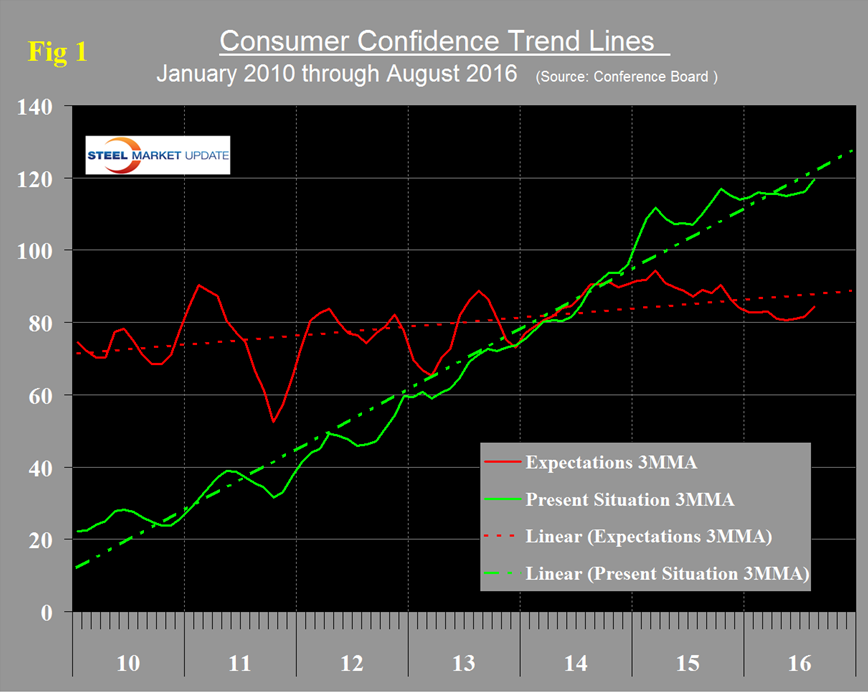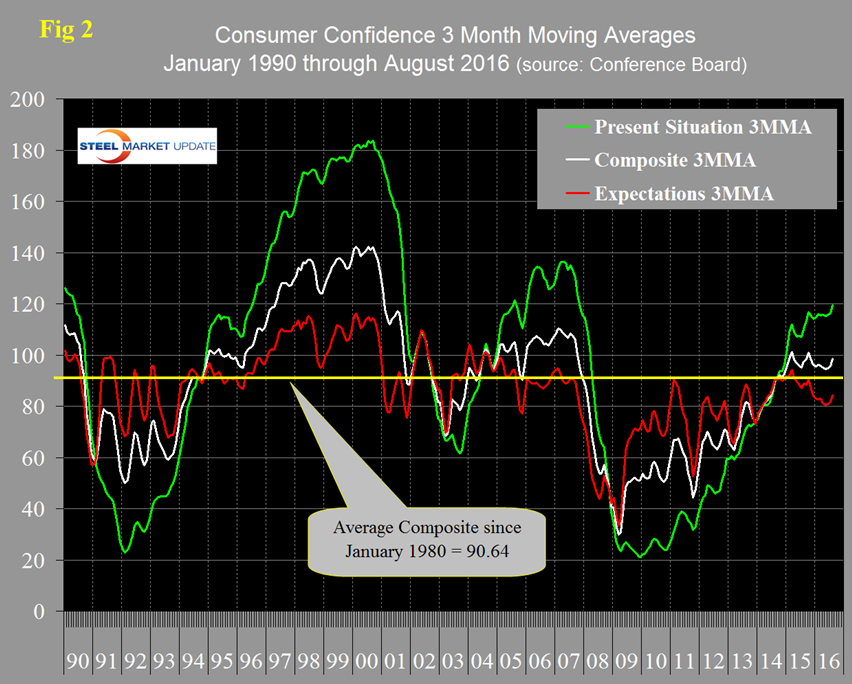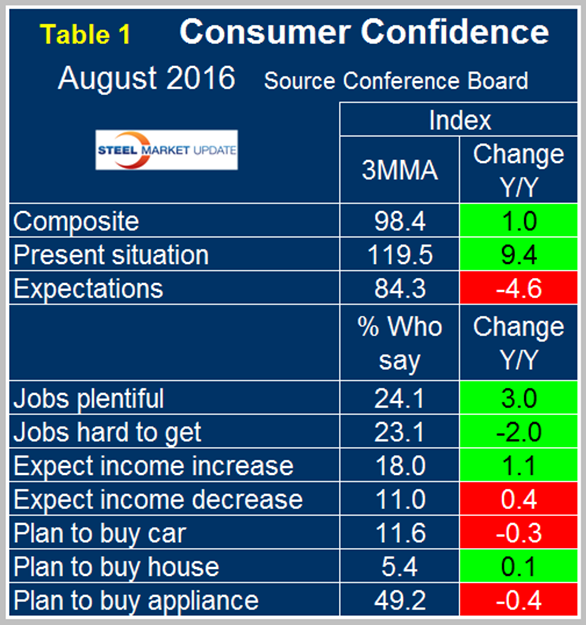Economy

Consumer Confidence in August 2016
Written by Peter Wright
August 30, 2016
The source of this data is the Conference Board with analysis by Steel Market Update. Please see the end of this piece for an explanation of the indicator.
Consumer Confidence jumped from 92.4 in May, its lowest value since July last year to 101.1 in August, its highest value since September last year. Included below is the official news release from the Conference Board. The three month moving average (3MMA) rose every month from 94.4 in May to 98.4 in August. We prefer to smooth the data in this way because of monthly volatility which in the case of Consumer Confidence has been quite extreme since the beginning of last year. The composite index is made up of two sub-indexes. These are the consumer’s view of the present situation and his/her expectations for the future. The 3MMA of the both the present situation and that of expectations have moved back towards their six year trend (Figure 1).
The present situation has been below its trend line since May and expectations have been below trend since December last year. The historical pattern of the 3MMA of the composite, the view of the present situation and expectations are shown in Figure 2.
The progression of the 3MMA of the composite was positive throughout 2014 into early 2015 but even with this welcome result in August is still not back to where it was in October last year. Since January last year the improvement in the present situation has been more than countered by the deterioration in consumer expectations. The improvement in the present situation in the period June through August is a welcome turnaround. Comparing August 2016 with August 2015 (y/y) the 3MMA of the composite was up by 1.0, the present situation was up by 9.4 and expectations were down by 4.6 (Table 1).
We have only been tracking the employment components of Consumer Confidence since August 2011 in which time both of the job availability components have improved every month. Expectations for wage increases have not been as consistent. August was the first month since February that there was an expectation of a wage increase on a 3MMA basis. Plans to buy homes were positive every month from May 2015 through May 2016 but were negative in June and July becoming slightly positive again in August. Plans to buy appliances improved every month this year until July and August when intentions became negative. Plans to buy a car became negative y/y in both July and August after being positive or neutral in April, May and June.
SMU Comment: Consumer Confidence is positively correlated with personal consumption which accounts for about 2/3 of GDP. Ultimately the growth of GDP positively drives steel consumption therefore the overall August improvement is welcome. The detail of consumer intentions to buy homes, appliances and automobiles is less encouraging.
The official news release from the Conference Board reads as follows and is entirely based on monthly changes. This is a highly regarded indicator which we believe needs to be examined in a longer time context to get the real picture which is why we only consider three month moving averages and focus our comments on year over year results.
The Conference Board Consumer Confidence Index, which had decreased slightly in July, increased in August. The Index now stands at 101.1 (1985=100), compared to 96.7 in July. The Present Situation Index rose from 118.8 to 123.0, while the Expectations Index improved from 82.0 last month to 86.4. “Consumer Confidence in August stood at its highest level in nearly a year, after a marginal decline in July,” said Lynn Franco, Director of Economic Indicators at The Conference Board. “Consumers’ assessment of both current business and labor market conditions was considerably more favorable than last month. Short-term expectations regarding business and employment conditions, as well as personal income prospects, also improved, suggesting the possibility of a moderate pick-up in growth in the coming months.”
Consumers’ appraisal of current conditions improved in August. Those stating business conditions are “good” increased from 27.3 percent to 30.0 percent, while those saying business conditions are “bad” remained virtually unchanged at 18.4 percent. Consumers’ assessment of the labor market was also more favorable. Those claiming jobs were more “plentiful” increased from 23.0 percent to 26.0 percent, however, those claiming jobs are “hard to get” also rose, from 22.1 percent to 23.4 percent.
Consumers’ optimism regarding the short-term outlook picked up in August. The percentage of consumers expecting business conditions to improve over the next six months increased from 15.7 percent to 17.3 percent, while those expecting business conditions to worsen decreased from 12.4 percent to 11.1 percent.
Consumers’ outlook for the labor market was also more favorable than in July. The proportion expecting more jobs in the months ahead rose from 13.5 percent to 14.2 percent, while those anticipating fewer jobs remained virtually unchanged at 17.5 percent. The percentage of consumers expecting their incomes to increase improved from 17.1 percent to 18.8 percent, while the proportion expecting a decline decreased marginally from 11.0 percent to 10.7 percent.
About The Conference Board
The Conference Board is a global, independent business membership and research association working in the public interest. Our mission is unique: To provide the world’s leading organizations with the practical knowledge they need to improve their performance and better serve society. The monthly Consumer Confidence Survey, based on a probability-design random sample, is conducted for The Conference Board by Nielsen, a leading global provider of information and analytics around what consumers buy and watch. The index is based on 1985=100. The composite value of Consumer Confidence combines the view of the present situation and of expectations for the next six months. The Conference Board is a non-advocacy, not-for-profit entity holding 501 (c) (3) tax-exempt status in the United States. www.conference-board.org

Peter Wright
Read more from Peter WrightLatest in Economy

ISM: Manufacturing expansion loses steam after two months of growth
US manufacturing activity slowed in March after two straight months of expansion, according to supply executives contributing to the Institute for Supply Management (ISM)’s latest report.

Chicago Business Barometer rose to 16-month high in March
The Chicago Business Barometer increased for the third-consecutive month in March. Despite this, it still reflects contracting business conditions, as it has since December 2023.

Durable goods orders rise again in February
Transportation equipment led the increase, rising 1.5% to $98.3 billion.

Consumer confidence falls for fourth consecutive month
People remain concerned about inflation, trade policies, and tariffs.

Housing starts ticked up in February
Single-family starts last month hit a rate of 1.10 million, a month-over-month increase of 11.4%, census data shows.



